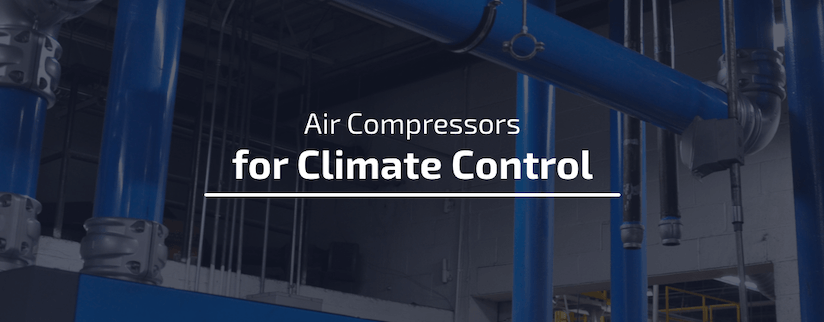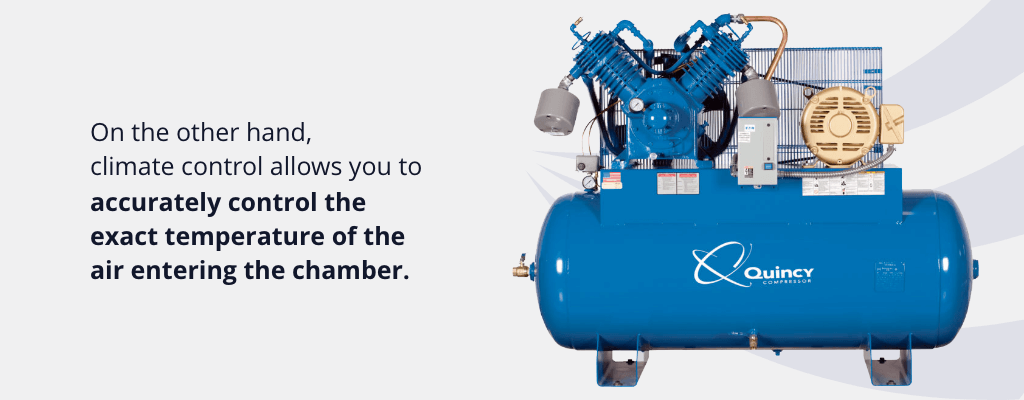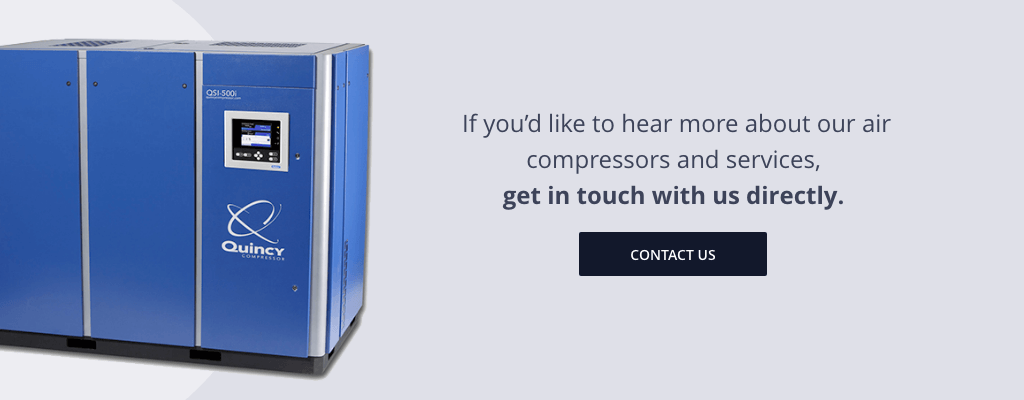January 6, 2022
Air Compressors for Climate Control
SHARE THIS POST

Are you on the hunt for a climate control system that will allow you to regulate the temperature and air quality in your indoor space? At C.H. Reed, we work with leading compressor manufacturers, like Quincy Compressor, to provide our customers with an array of premium systems and equipment for climate control applications.
Air compressors for climate control are specifically designed for low operating RPMs with durability in mind. They also provide users with minimal noise during application — an important aspect of every HVAC system. Climate control compressors are often piston machines, also known as reciprocating compressors. Rotary screw air compressors are also commonly used, as well as scroll compressors and variable speed compressors. As the weather outside becomes more intense, choosing a machine that will keep you cool and comfortable or warm and cozy is critical.
This guide takes a deeper look at how different industries and businesses use air compressors for climate control applications.
How Air Compressors Are Used in Climate Control Settings
Air compressors for climate control are usually comprised of reciprocating piston compressors and rotary screw compressors. In some high-end HVAC systems, scroll compressors are used. Lastly, variable speed air compressors are used in larger climate control settings.
So, how are these compressors used for climate control?
Reciprocating Compressor
Possibly the most popular type of air compressor option in climate control applications is a reciprocating air compressor.
This type of compressor employs pistons driven by a crankshaft to compress and deliver air. Office buildings and commercial spaces are outfitted with the necessary climate-control reciprocating air compressor to maintain comfortable environments, both cool and warm.
The process of reciprocating compressor functions are as follows:
- Air is sucked into the intake.
- Air passes through to the compression cylinder.
- Thereafter, the air is compressed by the crankshaft before the air is released.
Reciprocating compressors for climate control are available in single and two-stage in both base-mount and tank-mounted options:
- Simplex: Comprised of one pump and one motor, simplex splash lubricated units are typically for smaller operations.
- Duplex: Duplex splash lubricated piston machines come with two pumps and two motors, which is great for redundancy and larger operations.
Additionally, Quincy Compressor offers climate control reciprocating units that have a cast iron construction, ultra-dynamic gap rings, two-piece connecting rods, ASME-coded receiver tanks, and balanced flywheels. These units are available in 1/2 hp up to 20 hp options, and up to 100 PSIG service. They have a 2 ppm or less oil carryover rate, a high-efficiency intercooler, and an intake filter/silencer for lower noise levels.
Rotary Screw Compressor
Rotary screw air compressors are another type of air compressor for HVAC systems. Most rotary screw units in HVAC are very large systems. They’re a class of compressors that enacts positive displacement using twin spiral screws. These are drafted to generate volume around a cyclic pump in contact with a pressure-lowering chamber. You’ll find these mostly used in industrial applications, where larger volumes of compressed air are required.
The following steps describe how the rotary compressor process functions:
- Step 1: Air molecules are drawn into a vacuum chamber.
- Step 2: Particles move to a volume created by the pump.
- Step 3: A valve is used to compress a mass of molecules.
- Step 4: This compressed air is then pressurized and stored and ready to be used in a given application.
Scroll Compressor
In high-end HVAC systems, scroll compressors are frequently used and provide a relatively low-noise and vibration-free sound. This type of compressor doesn’t use any suction, but rather it employs crankshaft rotations and runs almost 100% efficiently in pumping trapped fluid.
The scroll compressor is mostly used in air conditioning equipment, as a supercharger for automobiles, and in vacuum pumps. Moreover, the system is popular in many residential central heating and air conditioning systems.
They are useful for climate control in large public spaces — including shopping malls, warehouses, and food courts — providing a favorable set of conditions regardless of the type of weather.
Variable Speed Compression
Variable-speed air compressors take advantage of variable-speed drive technology by controlling the unit’s rate (RPM) with a specific drive, saving a lot of energy over their fixed-speed counterparts.
Though typically a more expensive compressor upfront, variable speed compressors are beneficial for HVAC systems and function to reduce energy costs and the likelihood of power surges. These energy-efficient air compressors are ideal for climate management on a bigger scale, including skyscrapers, airports, stadiums, etc.

How Climate Control and Air Compressors Are Related
Let’s begin with what exactly air conditioning involves. Air conditioning is the process of condensing and drying air until it’s cold. At this point, it is pumped into the chamber using fans to offset warm ambient temperature from the exterior. This is done through a system of compressors, fans, and heat exchangers to allow cold air to enter.
On the other hand, climate control allows you to accurately control the exact temperature of the air entering the chamber. An effective temperature control air compressor is required to ensure that an HVAC system generates dry, low-oil – less than 2 ppm – clean air.
Climate control air compressors work in tandem with HVAC systems and are an essential part of controlling the comfortability and temperature of different environments around the world.
Typical Uses for Different Climate Control Compressors:
Rotary Screw Compressor
These air compressors are typically used for HVAC systems for industries, such as:
- Single or two-story office spaces
- Residential homes
- Apartment buildings
Reciprocating Compressor
These compressors are ideal for climate control systems and are typically used for split-air conditioners. You might find reciprocating compressors in:
- Refrigeration plants
- Oil refineries
- Manufacturing plants
- Restaurants and stores
- Office buildings
Scroll Compressor
These compressors are often seen in higher-end controls covering larger areas, including:
- Large public spaces
- Warehouses
- Shopping malls
Variable Speed Compressor
The variable-speed compressor system is ideal for large-scale climate control needs, such as:
- Skyscrapers
- Airports
- Stadiums
Contact C.H. Reed About Our Air Compressor Products and Services
C.H. Reed is among the leading suppliers of air compressors and industrial cooling systems of various types and sizes, providing an array of products and expert industry solutions for companies large and small. We work with leading manufacturers and utilize the latest advances in technology to resolve any compressed air challenges and add value to your business.
These specialized compressors provide an array of benefits to businesses, including an increase in energy savings, improved equipment quality and durability, a reduced impact on the environment, and much more. Whether you’re in utilities, food manufacturing, plastics and rubber processing manufacturing or another of a wide range of industries we serve, our products and services provide comprehensive solutions built just for you.
So, which climate control system for energy solutions will be the right pick for you? If you’d like to hear more about our air compressors and services, get in touch with us directly.
Search
Categories
Get a consultation
Related Posts
The 3 Distinct Advantages of Hydraulic Powered Pumps
Recently, C. H. Reed helped a major printing operation install a new ink pumping system. The new system needed to transfer four colors of high viscosity, heat-set ink to their three presses, drawing the ink from multiple 5,000…
Simple Ways to Reduce Waste in Your Spray Finishing System
In today’s demanding manufacturing landscape, it can be convenient to adopt a “cut-costs-at-all-costs” mentality, justifying questionable means for the sake of leaner production, a lower bottom line and increased profitability. Regrettably, those efforts can interfere…
What You Need to Know About Air-Powered Pressure Washers
Pressure washers are great solutions for your average cleaning applications, but what tool do you turn to for your more challenging applications? There are many instances where it is simply impossible to use a traditional…
